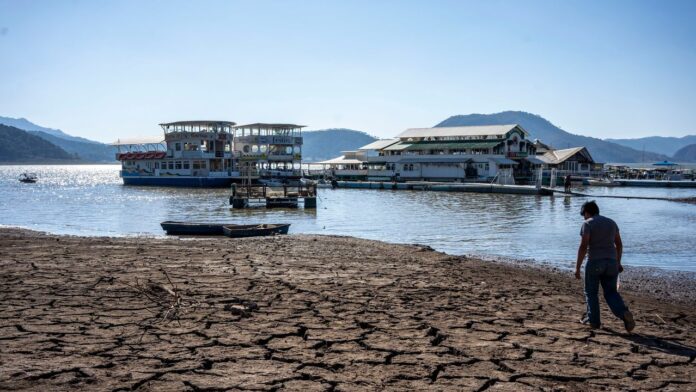Mexico City neighborhoods are being forced to ration water as the drought-stricken metropolis contends with a water crisis.
The big picture: The growing scarcity of water in several parts of Mexico is a bellwether of how worsening climate change may affect cities all over the world, experts say.
- Latin America accounts for one-quarter of the world’s agricultural and fisheries exports, but the increasing scarcity of water could hurt those. Roughly 14% of workers in Latin America and the Carribean work in agriculture, though that rate is much higher in particular countries, Bolivia, Ecuador, and Guatemala among them.
- Water scarcity has also been linked to depression, anxiety and increased rates of violence among people.
- “Water availability is set to be reduced further — by up to 40% in Mexico alone long-term — because drought-like conditions will continue to happen,” says Fabiola S. Sosa-Rodríguez, professor and researcher at the Autonomous Metropolitan University in Mexico.
Driving the news: The water supply systems for Mexico City’s metropolitan area and several other Mexican cities are at historic lows, according to the National Water Commission (Conagua), due to a lack of rain and other effects from last year’s El Niño.
- About 75% of the country has had drought-like conditions at some point in recent years, Sosa-Rodríguez says.
- Experts say that by June parts of the city’s central valley could reach “day zero,” when there isn’t enough water to pump out to the city, even if the typical rainy season starts that month.
- A former Conagua director, José Luis Llegue, said last month that day zero could happen as soon as April because of continuous high temperatures.
Background: Greater Mexico City, home to roughly 21 million people, gets its water from reservoirs and ground aquifers, which experts have long warned are at risk of overuse.
- Estimates show 2.15 times more water is taken out of the aquifers than is recharged or recovered.
- Most of the water is then distributed through the Lerma-Cutzamala system, a series of dams, storage tanks, ground pipes and pumping stations that is troubled by leaks from earthquakes and aging infrastructure and has been operating for twice as long as it was designed to.
What to know: Authorities have been implementing scheduled rationing in some municipalities for the last month and a half, hitting both high income and poverty-ridden areas.
- For years they have also tried to lessen the impact by sending out “pipas,” or water tank trailers, to fill neighborhood plastic tanks.
- Yes, but: Experts say that’s repeatedly been shown not to be enough.
A new report from the National Autonomous University of Mexico and group Agua Capital urges authorities, private companies and residents to immediately adopt mitigation strategies, including:
- Legislation and corporate rules so that water for crops or certain factories is mostly taken from wastewater treatment rather than freshwater.
- Investments for maintenance of the Cutzamala and to reforest and recover wetlands that favor rain.
- Setting up more rainwater collection and harvesting systems in homes.
What they’re saying: “This crisis being felt across the country can serve as an opportunity to finally make changes that have been needed but postponed due to budget reasons, or other priorities and lack of political will,” says Sosa-Rodríguez.
- “Now is when practically everyone agrees that this needs to be done.”
Subscribe to Axios Latino to get vital news about Latinos and Latin America, delivered to your inbox on Tuesdays and Thursdays.



